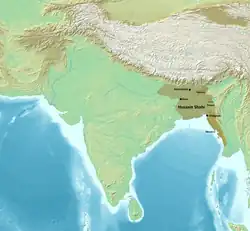Ḥussain Shāhī
| |
|---|---|
| Royal house | |
 Map of the Hussain Shahi dynasty of the Bengal Sultanate, including its vassals and occupation in Assam.[1] | |
| Country | Bengal Sultanate |
| Current region | Bengal, Bihar |
| Etymology | Name of Alauddin Husain Shah |
| Founded | 1494 |
| Founder | Alauddin Husain Shah |
| Final ruler | Ghiyasuddin Mahmud Shah |
| Titles | Sultan |
| Members | Nasiruddin Nasrat Shah Alauddin Firuz Shah II Syeda Momena Khatun |
| Connected members | Ibrahim Danishmand, Khidr Khan Surak, Isa Khan |
| Traditions | Sunni Islam |
| Estate(s) | Gaur |
| Deposition | 1538 |
The Hussain Shahi dynasty (Bengali: হোসেন শাহী খান্দান, Pashto: د حسین شاهي کورنۍ, Persian: حسين شاهی خاندان) was a family which ruled the late medieval Sunni Muslim Sultanate of Bengal from 1494 to 1538.[2]
History
The dynasty's founder, Alauddin Husain Shah was possibly of Sayyid Arab,[3][4][5] or even Afghan origin.[6][7] He is considered as the greatest of all the sultans of Bengal for bringing a cultural renaissance during his reign. He conquered Kamrup-Kamata and Orissa and extended the Sultanate all the way to the port of Chittagong, which witnessed the arrival of the first Portuguese merchants. His supposed heir, Shahzada Danyal, who he had appointed as the governor of Kamata, was executed by rebellious chieftains in Assam.
Husain Shah's son and successor, Nasiruddin Nasrat Shah, gave refuge to the Afghans during the invasion of Babur though he remained neutral. Known as the Akbar of Bengal, Nasrat was known by the Hindus of Bengal as Nripati Tilak and Jagatbhusan. He encouraged the translation of Sanskrit literature into the Bengali language and built the Chota Sona Masjid. Nasrat Shah's treaty with Babur saved Bengal from a Mughal invasion.
The last Sultan of the dynasty, Ghiyasuddin Mahmud Shah, who continued to rule from Sonargaon, had to contend with rising Afghan activity on his northwestern border. Eventually, the Afghans under the Sur Empire broke through and sacked the capital in 1538 where they remained for several decades, successively establishing two independent dynasties (Muhammad Shahi and Karrani).[8] However, the Bengal Sultanate collapsed not long after, transforming Bengal into a confederacy of chieftains known as the Baro-Bhuiyans. This loose confederacy of Bengal was ruled by Isa Khan, one of Ghiyasuddin Mahmud Shah's grandsons through his daughter Syeda Momena Khatun. Khan was subsequently succeeded by his son, Musa Khan, though his grandson, Masum Khan, was a mere zamindar.[9]
Rulers
| Titular Name(s) | Personal Name | Reign | |
|---|---|---|---|
| Sultan `Ala ad-Din سلطان علاء الدين Bengali: সুলতান আলাউদ্দীন |
Husayn Shah حسين شاه Bengali: হুসেন শাহ |
1494–1519 | |
| Sultan Nasir ad-Din سلطان ناصر الدين Bengali: সুলতান নাসিরউদ্দীন |
Nasrat Shah نصرت شاه Bengali: নসরত শাহ |
1519–1533 | |
| Sultan `Ala ad-Din سلطان علاء الدين Bengali: সুলতান আলাউদ্দীন |
Firuz Shah فيروز شاه Bengali: ফিরোজ শাহ |
1533 | |
| Sultan Ghiyath ad-Din سلطان غياث الدين Bengali: সুলতান গিয়াসউদ্দীন |
Mahmud Shah محمود شاه Bengali: মাহমূদ শাহ |
1533–1538 | |
| Suri rule takes over Bengal under Sher Shah Suri in 1538 C.E. | |||
| Part of a series on the |
| Bengal Sultanate |
|---|
 |
See also
References
- ↑ "-- Schwartzberg Atlas -- Digital South Asia Library". dsal.uchicago.edu. Retrieved 14 September 2023.
- ↑ For a map of their territory see: Schwartzberg, Joseph E. (1978). A Historical atlas of South Asia. Chicago: University of Chicago Press. p. 147, map XIV.4 (f). ISBN 0226742210.
- ↑ Eaton, Richard M. (1993). The Rise of Islam and the Bengal Frontier, 1204-1760. University of California Press. p. 63. ISBN 978-0-520-20507-9.
Ala al-Din Hasan, a Mecan Arab...
- ↑ Markovits, Claude (24 September 2004). A History of Modern India, 1480-1950. Anthem Press. p. 38. ISBN 978-1-84331-152-2.
- ↑ Jr, Everett Jenkins (7 May 2015). The Muslim Diaspora (Volume 1, 570-1500): A Comprehensive Chronology of the Spread of Islam in Asia, Africa, Europe and the Americas. McFarland. p. 335. ISBN 978-1-4766-0888-4.
- ↑ Subrahmanyam, Sanjay (2012). The Portuguese Empire in Asia, 1500-1700: A Political and Economic History. John Wiley & Sons. ISBN 9781118274026.
In their embassy to Bengal, at the time under the control of the Afghan Hussain Shahi dynasty,
- ↑ Chatterjee, Pranab (2010). A Story of Ambivalent Modernization in Bangladesh and West Bengal: The Rise and Fall of Bengali Elitism in South Asia. Peter Lang. p. 84. ISBN 9781433108204.
- ↑ "The Hussain-Shahi Dynasty".
- ↑ Abdul Kader, Mohammad (1988). Historical Fallacies Unveiled. Islamic Foundation Bangladesh.